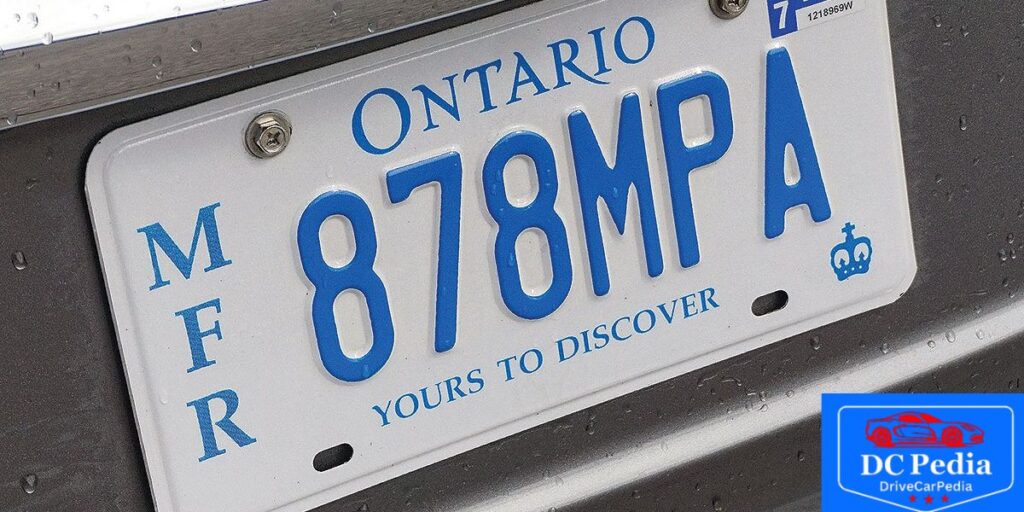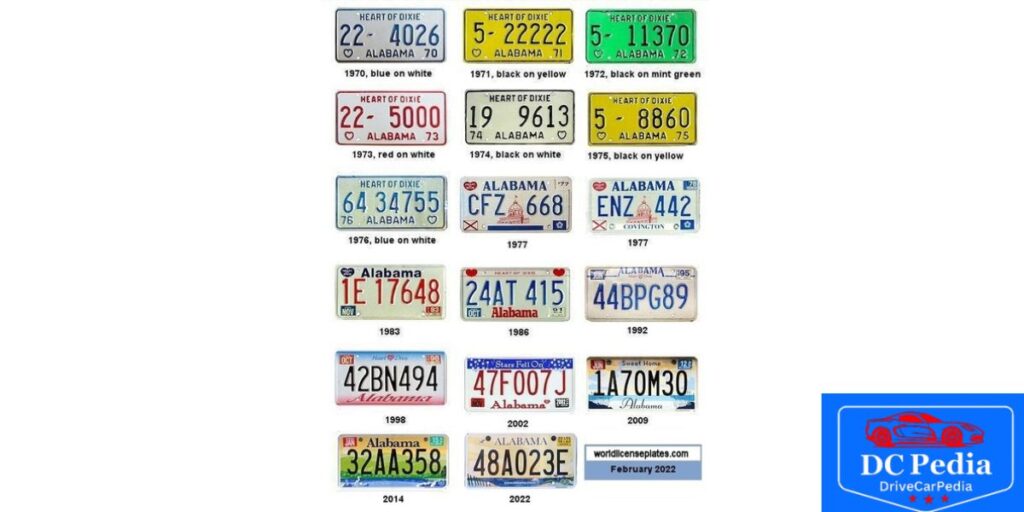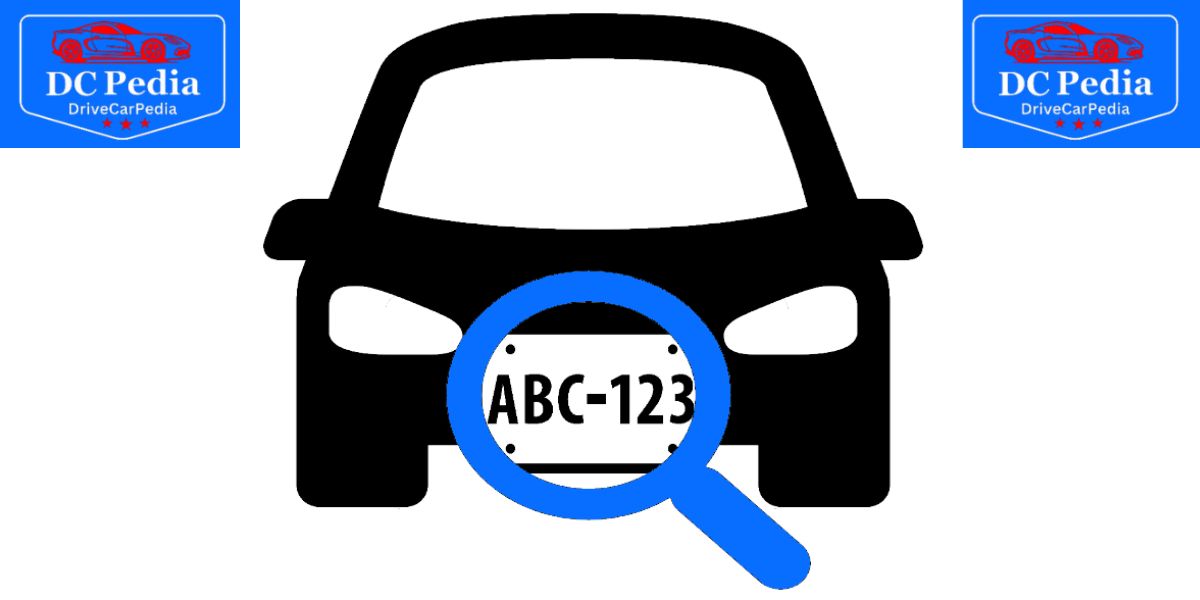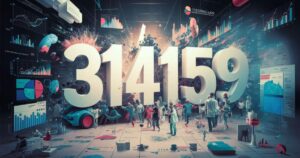The easiest way to find your license plate number is to look at your vehicle’s license plates where the number is clearly displayed. You can locate the plate on the rear of your car or on the front of your car if you live in a state that requires plates on both ends.
If you do not have access to your vehicle you can find the license plate number on your car’s registration documents. The registration papers will list your vehicle details and license plate number which was assigned when you registered your car with the DMV.
Your license plate number may be needed even if you don’t have the vehicle handy. You don’t remember it? There are other ways to locate it, so don’t worry.
What Are License Plates?
License plates are metal or plastic plates attached to vehicles. Each plate has a unique registration number and information. The purpose is to identify vehicles legally operated on roads.
All states require rear license plates displayed on cars. Some require front plates too. Plates were once made of each year’s date stamped in metal. Georgia started using date decals so plates could be reused, saving costs. Proper display is important to follow laws.
What Are License Plates Made Of?
Modern license plates are made of aluminum. It is lightweight and easy to recycle by melting down and casting into new items. There are two main types of plates used.
Flat steel dies are made by stamping steel sheets. These are commonly used for passenger vehicles due to lower cost. Stamped steel dies are individual pieces cut and formed from steel sheets. These are typically used for commercial vehicles and can be more expensive to produce.
Here are three paragraphs describing common types of license plates
Standard plates are issued for most vehicles like cars, trucks, motorcycles, trailers and RV’s. They have basic design and numbering.
Specialty plates support causes like arts or charities. Fees added support chosen organizations. Special plates recognize achievements, history or status. Examples include military service plates, classic car plates and ham radio plates. Other types include dealership plates and farm use plates with cheaper rates. Occupations can getunique plates like for transport companies.
Some states offer new digital plates which display plate numbers digitally. These require additional fees and can change date or other info digitally. Personalized vanity plates let owners select their own combinations if available.

Who Issues License Plates?
In most states, the Department of Motor Vehicles (DMV) is responsible for issuing license plates. The DMV handles driver’s licenses and vehicle registrations. Some states have a separate agency that oversees plates, such as the Department of Transportation. It is through the DMV process that new owners receive plates when registering a vehicle for the first time or transferring ownership.
Applying For New License Plates
Applying for new license plates involves gathering documents and following steps that vary by state. For a first-time registration, you need to prove ownership with the vehicle’s title and your valid driver’s license. You must also provide proof of insurance and details like the VIN, make and model.
An important part is paying the registration fee. Some states incorporate plate costs in this while others charge separately. An odometer reading may be required too. Your current valid registration card also serves as valid ID.
When transferring a vehicle from a dealer or private seller, you pay a transfer charge set by your state. Most places also collect sales tax when purchasing a used vehicle. You have the option of transferring old plates to a new car in some states.
Once you collect the needed proofs like your title, license and insurance info, you can register either online or directly at your local DMV office. There, you pay all applicable costs. Within a few weeks, your new plates should arrive in the mail. For temporary operation, some states offer temporary permit plates too after partial payment.
Proper registration is essential to legally drive your vehicle on public roads. Applying for plates ensures your vehicle and yourself are properly documented with the DMV or related transportation agency.
DMV License Plate Replacement
If you need to replace lost, stolen or damaged license plates, you must visit your local Department of Motor Vehicles office. You may be able to order replacement plates online depending on your state. The DMV will require documentation like your vehicle registration card and proof of identity like a driver’s license.
You may have to pay a fee for replacement plates that varies by state. Specialty or personalized plates require submitting a new application and paying design/personalization fees again. The DMV can also issue temporary registration documents until your new plates arrive.
If you need a temporary license plate, you should be aware that every state has different requirements for issuing temporary license plates. Commonly required documents include:
Certificate of Title
Temporary car tag application
A valid driver’s license or ID cards
Results of inspections or emissions testing, if applicable
Loan documentation or release, if applicable
Some states require you to show multiple forms of vehicle identification. Typically, one must be a government-issued ID card, while the other can be something like a vehicle registration, bank statement, or utility bill.
Types Of License Plates
In the United States, a variety of license plate types are issued. Here are some of the most common types of license plates:
- Standard plates are issued for most passenger vehicles like cars, trucks and SUVs. They feature a basic design that typically includes the state name and identification number.
- Specialty plates allow drivers to display support for various causes like environmental groups or arts programs. Extra fees from these plates go towards the supported organization.
- Special license plates recognize accomplishments, careers or statuses. Military plates honor service members. Purple Heart plates recognize injured veterans. Historical plates denote antique vehicles. HAM radio operators get HAM plates.
- Occupational plates are made for careers like auto dealers, tow truck drivers or mechanics. Legislative plates identify officials’ vehicles. Farm plates are less expensive for agricultural use vehicles.
- Off-highway vehicle plates are stickers for off-road only machines not driven on public roads.
- Digital license plates are a newer option where the numbers are displayed digitally allowing for easy customization of dates or messages. So far they are available in California, Arizona, Texas and Michigan.
- Temporary license plates provide short-term registration when first purchasing a vehicle while permanent plates are awaiting production and delivery.
- Special event plates promote time-limited designs celebrating holidays, anniversaries or local attractions. Fees above normal costs fund related programs and initiatives.

No matter the plate type, all must clearly display the vehicle’s registered identification number and stickers showing valid dates of registration. Plates are crucial for roadway law enforcement and identification.
What Does The License Plate Number mean?
The first one or two letters on a license plate signify the state that issued the plates. For example, “CA” stands for California, “TX” stands for Texas, and “NY” represents New York.
After the state identifier, some plates include one or two letters that correspond to the county or district where the vehicle was registered. So someone can see a car with plates starting “CA-S” and know it’s from San Diego County in California.
Following the county/district code are numbers, usually two to four digits. In some areas these numbers help track annual registrations and renewals, with lower numbers indicating older registrations. Other states assign random numerical groups.
On most standard passenger vehicle plates, the full number string including letters and digits is unique for each registered vehicle. Combinations are carefully monitored by statewide DMV databases to avoid duplication.
In addition to the basic registration information, specialty and personalized plates can convey extra details. Vanity configurations are chosen by owners within character limits. And organizational plates specify a supported cause.
In short, a license plate number starting with the issuing state code and containing unique letters and numerals helps law enforcement and citizens properly identify the registration information for each vehicle operating on public roads. The full number string is the primary tracking identifier used by DMV records nationwide.
Reasons To Find Your License Plate Number
License plates are required on all vehicles in every state. As a result, your license plate number is an important piece of information. Here are a few reasons why may be looking for your license plate number:
Your license plates were stolen
If someone stole the license plates off your car, you’ll need to contact the DMV and provide your vehicle’s license plate number. This helps them identify your specific vehicle record so they can issue you replacement plates. You’ll also need to file a police report about the theft.
Your car was stolen
If unfortunately your entire car gets stolen, giving the police your license plate number allows them to enter it into their nationwide database. Then if law enforcement in another city spots your car, they’ll know it’s stolen and can work to recover it. The license plate is a key piece of identifying information.
To buy a new or used car
When you purchase a used vehicle from a private seller or dealership, the license plate number is important paperwork the seller will need to officially transfer the vehicle’s title and registration over to your name. Many motor vehicle departments require this number be provided. Dealers may even ask to double check the plate matches the car.
To renew your vehicle registration
Most places require re-registering vehicles annually or every few years. To complete the renewal process, you’ll need to give the DMV your current license plate number. It helps them lookup License Plate your specific vehicle record and updates it with your new registration stickers or tag.
To rent a trailer or moving truck
Rental companies need to know the license plate numbers of any vehicles they rent out, like cargo trailers or moving trucks. This is in case anything happens while you have it rented, like it’s in an accident, they know exactly which vehicle to reference in their records under your name.
To report an accident
In the unfortunate event you’re involved in a car crash, the responding police will require the license plate numbers of all vehicles involved. Your insurance company investigating any claims will also need this information to determine details like vehicle ownership and fault. It’s a key detail reported for accident records.
Ways To Find Your License Plate Number
Here are some ways to find your vehicle’s license plate number
Find The License Plate Number…On The Car’s License Plate
The most obvious place to look is directly on the physical license plate attached to the front and back of the vehicle.
How To Find The License Plate Number In Your Car’s Registration Documents
If the physical plate is missing or illegible, check your vehicle registration card that you received from the DMV. This document lists the plate number.
Finding the License Plate Number via Insurance
Log into your auto insurance online account or app. Your current license plate number should be part of the vehicle and policy details on file.
How To Find License Plate Number By Name
Some DMV websites allow searching their records by vehicle owner’s name to retrieve license plate numbers. You may need to provide additional ID details.
Where Can I Find My License Plate Number Online?
Log into your state DMV website. Many offer online license plate lookup tools requiring your driver’s license or other ID to verify identity and access record information including plate numbers.
How Do I Find My Old License Plate Number
If you no longer own a vehicle and need a past license plate number, contact the DMV. Provide identifying details like your name, address during ownership, VIN and approximate years. The DMV should be able to retrieve prior plate numbers issued for a vehicle no longer in your possession if needed.

How To Find License Plate Number From VIN?
One way to find the license plate number associated with a vehicle is by using the VIN, or vehicle identification number. The VIN is a unique 17-character code that identifies each individual car, truck, or motor vehicle. It can be found embossed on a metal plate located inside the driver’s side door frame or windshield pillar. With the VIN, you can contact the department of motor vehicles in the state where the vehicle is registered. Provide them the VIN and they should be able to look up the registration record and provide the license plate number associated with that specific vehicle.
Some states allow you to search license plate numbers online through their DMV website portals. On many sites, you can conduct a VIN search which will retrieve the registration record and display the current license plate number. This provides a convenient method to find the number without having to call the DMV. However, availability varies between states and counties, so you may still need to contact them directly in some areas. The DMV database tracks vehicles by VIN, so providing this permanent identification code is usually the best way for them to match it to the license plate assigned.
How To Find License Plate Number By VIN Free
Some options to find a license plate number for free by VIN include using VIN checking services online or auto history report sites. Entering the VIN on sites like vehiclehistory.com or autotempest.com may retrieve the last known registration details including plate number, depending on how comprehensive their records are.
You can also try searching general web searches by combining the VIN with keywords like “license plate” and the registered state to see if any public records turn up the information. These free methods aren’t always reliable so it’s best to use DMV resources as a last resort.
What To Do If The Vehicle Doesn’t Have a VIN?
If the vehicle does not have a visible or intact VIN, it becomes much more difficult to find the license plate number. In this case, the best approach would be to contact the DMV in the state where the vehicle is located and report that it has no VIN. The DMV may be able to provide more identification details like the make, model, color and previous owners to try and locate the registration record associated with the vehicle.
As a last measure, you can also try searching vehicle registration databases online using as many identifying details as possible. But without a VIN for verification, it’s unlikely you’ll be able to find the license plate number for certain through free methods alone.
Buying or Selling A Car with PrivateAuto
PrivateAuto makes private car transactions easy and safe. Our innovative platform connects buyers and sellers and gives them all the tools to complete the deal, from in-app financing to secure messaging to integrated payments. Get started with PrivateAuto today.
- Create a PrivateAuto Account: Sign up for a free seller account on the PrivateAuto website or mobile app.
- Provide Vehicle Details: Enter information like make, model, year, mileage, condition and features. Upload photos.
- Get a Current Value Estimate: PrivateAuto uses their valuation tools to provide a price range for your specific vehicle.
- List Your Car for Sale: Choose a price within the estimated range and submit your vehicle listing.
- Market Your Listing: PrivateAuto promotes your car to hundreds of thousands of potential buyers.
- Handle Inquiries: Respond to messages from interested buyers and schedule test drives if wanted.
- Accept an Offer: Negotiate offers and accept one that meets your minimum selling price.
- Meet Up with the Buyer: Meet to complete paperwork, payment and Drive Away with Car Sold status.
- Get Paid: Payment is processed by PrivateAuto and deposited into your bank account.
- Leave Feedback: Rate your buyer experience which helps build buyer/seller reputation profiles.
License Plate Number FAQ
Can You Lookup Someone’s License Plate Number?
Yes, many states allow the public to search license plate records online through their DMV website. Some private services also allow lookups.
What is a DMV license plate lookup?
A DMV license plate lookup searches the state Department of Motor Vehicles database to retrieve the registered owner information for a specific license plate number.
How do I find my PA license plate number?
You can find your PA license plate number on the physical plate, vehicle registration card, your insurance documents, or by logging into your account on the Pennsylvania DMV website.
Is license plate information public record in Florida?
Yes, license plate and vehicle registration records are considered public information in Florida and can be searched on the Florida DMV website.
How do I check my car tag in Florida?
You can check your Florida vehicle registration (“tag”) information, including your license plate number, by searching your record on the Florida DMV website.
What is the best VIN lookup service?
Popular free VIN lookup services are sites like vehiclehistory.com, autocheck.com, and vincheck.info. Paid services like Carfax provide more detailed vehicle history reports.
How do I get new state license plates after moving to a new state?
When you move to a new state, you must register your vehicle in that state within a certain period of time. Contact the new state’s DMV to exchange your plates for their state plates.
How can I clean my license plates?
Use water and a mild dish soap or detergent on a soft cloth or brush to scrub license plates clean of dirt, bugs, salt or other debris.
What size are license plate screws?
Standard license plate screws in the US are #8-32 size, which refers to a diameter of 0.131 inches and 32 threads per inch.
Should I Remove License Plates When Selling a Car In California?
In California, license plates should remain on the vehicle until ownership is legally transferred to the new buyer at the DMV.
How Can I Trace a License Plate?
You can conduct a public records search on a license plate number using your state DMV website or hiring a private investigator to perform a deeper background trace.
Can a Civilian Run a License Plate?
Yes, members of the public can search license plate records through their state DMV website as these records are considered public information in most states.









